Abstract
Purified human native third component of complement, C3, was found to inhibit in vitro natural killer (NK) cell cytotoxicity in both mouse and human systems. The effect was dose and time dependent, a 50% inhibition being reached with 190 nM C3 (35 micrograms/ml) added during the NK assay or after a 30-min preincubation of the effector cells with this C3 concentration. C3 was shown to act at the effector-cell population level because pretreatment of the target cells did not modify the NK lysis. The inhibition was not due to general cytotoxicity nor to cell agglutination. Moreover, another in vitro cytotoxicity system (represented by alloreactive cytotoxic lymphocytes) was not affected by purified C3. Structural analysis of the active part of the C3 molecule shows that the C3-induced inhibition is supported by the C3a fragment. Release of carboxyl-terminal arginine residue by carboxypeptidase B, converting C3a into des-Arg77-C3a, did not alter the inhibitory effect displayed by this fragment. These results suggest that C3a may play an important role in the regulation of NK activity.
Full text
PDF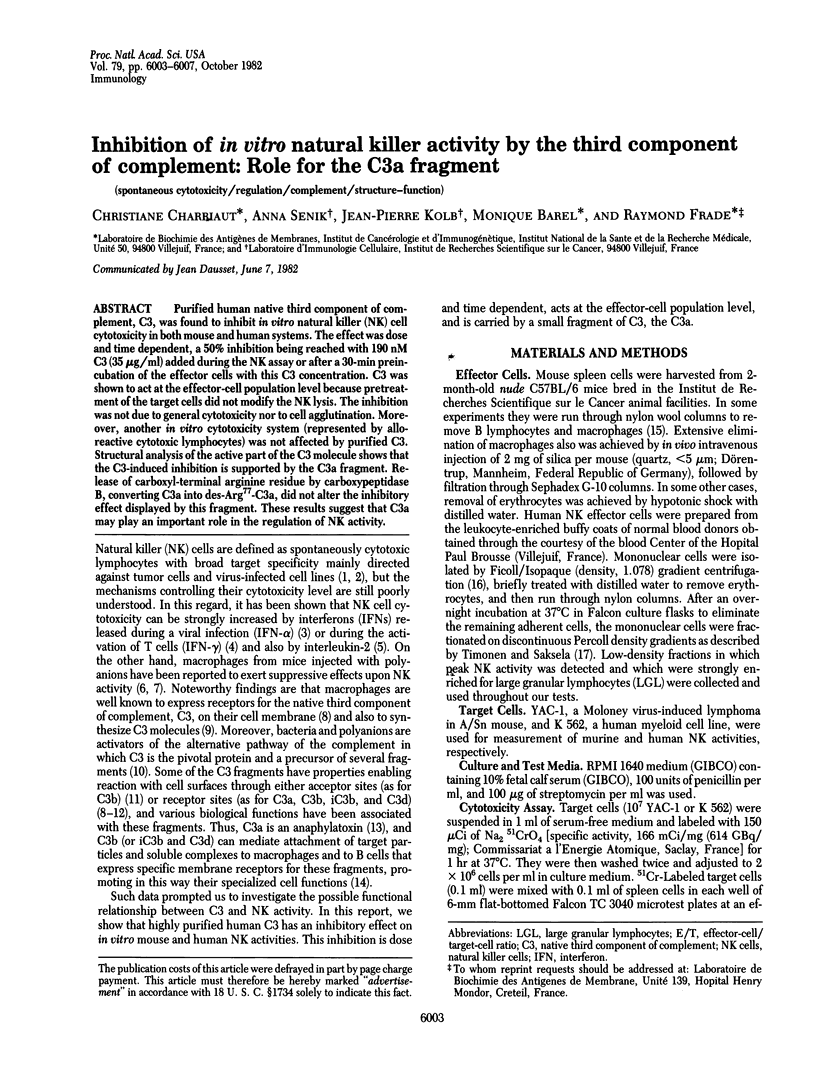
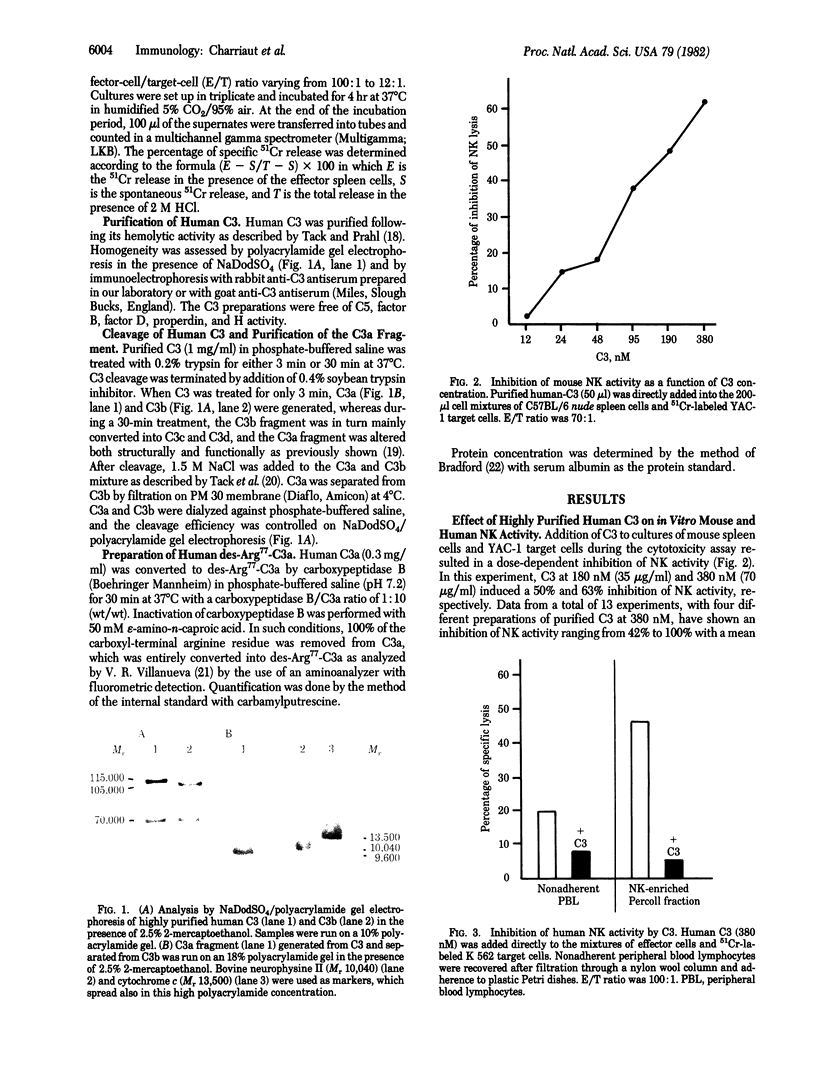
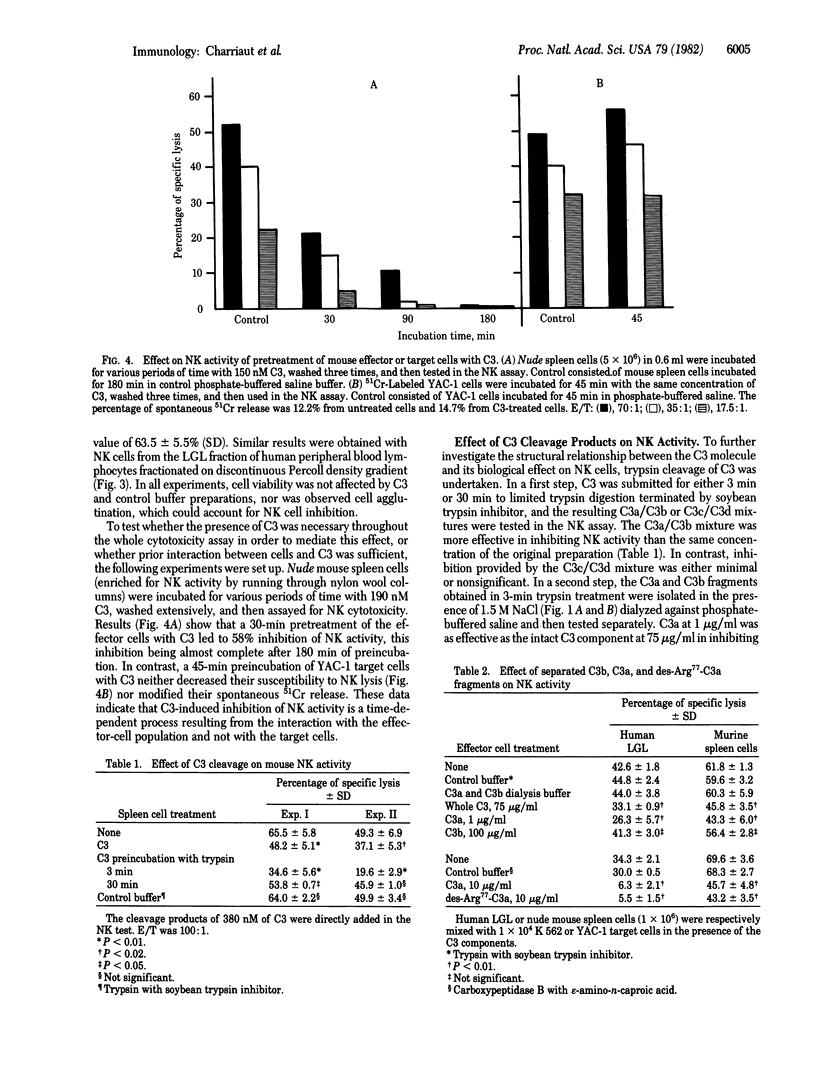
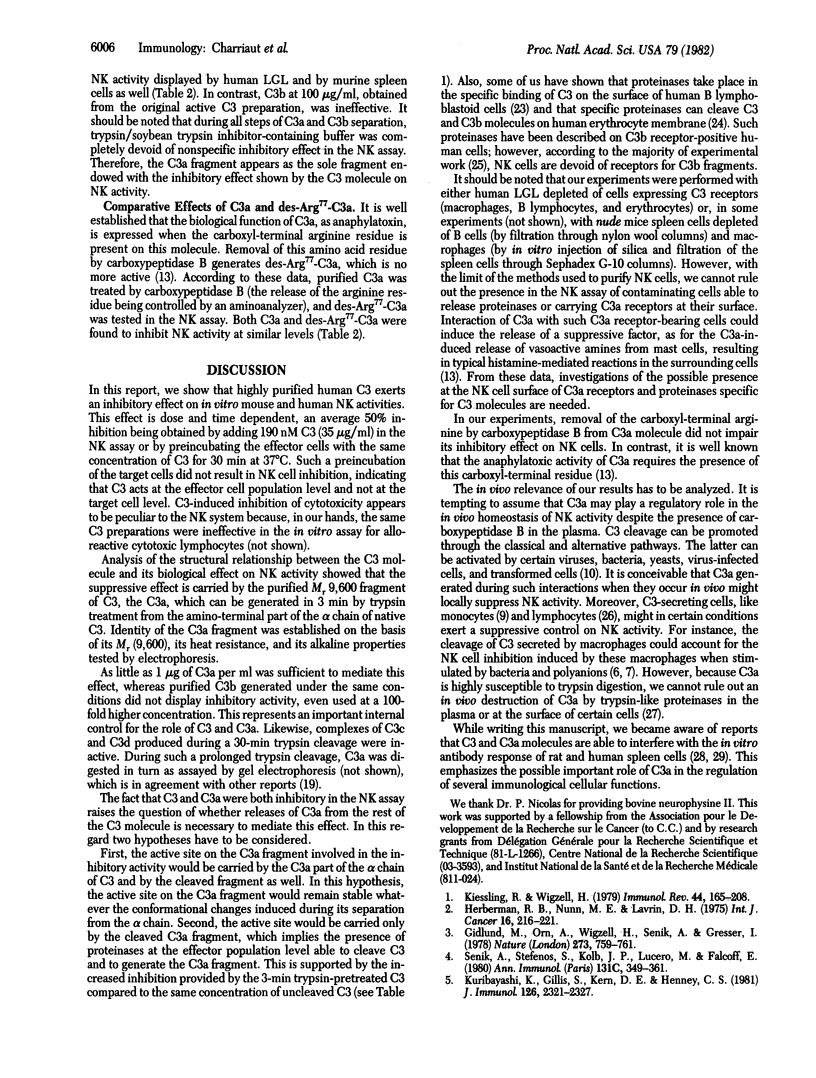
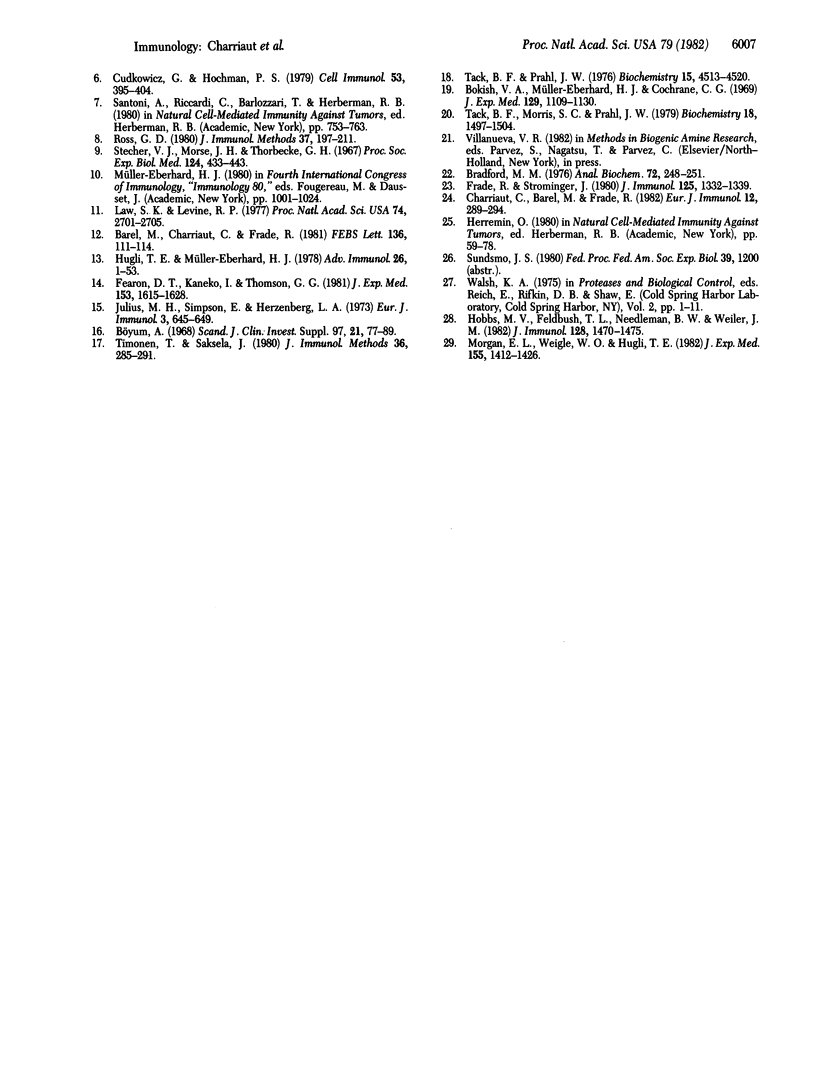
Images in this article
Selected References
These references are in PubMed. This may not be the complete list of references from this article.
- Barel M., Charriaut C., Frade R. Isolation and characterization of a C3b receptor-like molecule from membranes of a human B lymphoblastoid cell line (Raji). FEBS Lett. 1981 Dec 21;136(1):111–114. doi: 10.1016/0014-5793(81)81225-2. [DOI] [PubMed] [Google Scholar]
- Bokisch V. A., Müller-Eberhard H. J., Cochrane C. G. Isolation of a fragment (C3a) of the third component of human complement containing anaphylatoxin and chemotactic activity and description of an anaphylatoxin inactivator of human serum. J Exp Med. 1969 May 1;129(5):1109–1130. doi: 10.1084/jem.129.5.1109. [DOI] [PMC free article] [PubMed] [Google Scholar]
- Bradford M. M. A rapid and sensitive method for the quantitation of microgram quantities of protein utilizing the principle of protein-dye binding. Anal Biochem. 1976 May 7;72:248–254. doi: 10.1016/0003-2697(76)90527-3. [DOI] [PubMed] [Google Scholar]
- Charriaut C., Barel M., Frade R. Behavior of soluble human 125I-labeled C3b, the third component of complement, after binding to human cells. Eur J Immunol. 1982 Apr;12(4):289–294. doi: 10.1002/eji.1830120407. [DOI] [PubMed] [Google Scholar]
- Cudkowicz G., Hochman P. S. Carrageenan-induced decline of natural killer activity. I. In vitro activation of adherent non-T-suppressor cells. Cell Immunol. 1980 Aug 1;53(2):395–404. doi: 10.1016/0008-8749(80)90340-8. [DOI] [PubMed] [Google Scholar]
- Fearon D. T., Kaneko I., Thomson G. G. Membrane distribution and adsorptive endocytosis by C3b receptors on human polymorphonuclear leukocytes. J Exp Med. 1981 Jun 1;153(6):1615–1628. doi: 10.1084/jem.153.6.1615. [DOI] [PMC free article] [PubMed] [Google Scholar]
- Frade R., Strominger J. Binding of soluble 125I-human C3b, the third component of complement, to specific receptors in human cultured B lymphoblastoids cells: characterization of a low affinity interaction. J Immunol. 1980 Sep;125(3):1332–1339. [PubMed] [Google Scholar]
- Gidlund M., Orn A., Wigzell H., Senik A., Gresser I. Enhanced NK cell activity in mice injected with interferon and interferon inducers. Nature. 1978 Jun 29;273(5665):759–761. doi: 10.1038/273759a0. [DOI] [PubMed] [Google Scholar]
- Herberman R. B., Nunn M. E., Lavrin D. H. Natural cytotoxic reactivity of mouse lymphoid cells against syngeneic acid allogeneic tumors. I. Distribution of reactivity and specificity. Int J Cancer. 1975 Aug 15;16(2):216–229. doi: 10.1002/ijc.2910160204. [DOI] [PubMed] [Google Scholar]
- Hobbs M. V., Feldbush T. L., Needleman B. W., Weiler J. M. Inhibition of secondary in vitro antibody responses by the third component of complement. J Immunol. 1982 Mar;128(3):1470–1475. [PubMed] [Google Scholar]
- Hugli T. E., Müller-Eberhard H. J. Anaphylatoxins: C3a and C5a. Adv Immunol. 1978;26:1–53. doi: 10.1016/s0065-2776(08)60228-x. [DOI] [PubMed] [Google Scholar]
- Julius M. H., Simpson E., Herzenberg L. A. A rapid method for the isolation of functional thymus-derived murine lymphocytes. Eur J Immunol. 1973 Oct;3(10):645–649. doi: 10.1002/eji.1830031011. [DOI] [PubMed] [Google Scholar]
- Kiessling R., Wigzell H. An analysis of the murine NK cell as to structure, function and biological relevance. Immunol Rev. 1979;44:165–208. doi: 10.1111/j.1600-065x.1979.tb00270.x. [DOI] [PubMed] [Google Scholar]
- Kuribayashi K., Gillis S., Kern D. E., Henney C. S. Murine NK cell cultures: effects of interleukin-2 and interferon on cell growth and cytotoxic reactivity. J Immunol. 1981 Jun;126(6):2321–2327. [PubMed] [Google Scholar]
- Law S. K., Levine R. P. Interaction between the third complement protein and cell surface macromolecules. Proc Natl Acad Sci U S A. 1977 Jul;74(7):2701–2705. doi: 10.1073/pnas.74.7.2701. [DOI] [PMC free article] [PubMed] [Google Scholar]
- Morgan E. L., Weigle W. O., Hugli T. E. Anaphylatoxin-mediated regulation of the immune response. I. C3a-mediated suppression of human and murine humoral immune responses. J Exp Med. 1982 May 1;155(5):1412–1426. doi: 10.1084/jem.155.5.1412. [DOI] [PMC free article] [PubMed] [Google Scholar]
- Ross G. D. Analysis of the different types of leukocyte membrane complement receptors and their interaction with the complement system. J Immunol Methods. 1980;37(3-4):197–211. doi: 10.1016/0022-1759(80)90307-5. [DOI] [PubMed] [Google Scholar]
- Senik A., Stefanos S., Kolb J. P., Lucero M., Falcoff E. Enhancement of mouse natural killer cell activity by type II interferon. Ann Immunol (Paris) 1980 May-Jun;131C(3):349–361. [PubMed] [Google Scholar]
- Stecher V. J., Morse J. H., Thorbecke G. J. Sites of production of primate serum proteins associated with complement system. Proc Soc Exp Biol Med. 1967 Feb;124(2):433–438. doi: 10.3181/00379727-124-31758. [DOI] [PubMed] [Google Scholar]
- Tack B. D., Prahl J. W. Third component of human complement: purification from plasma and physicochemical characterization. Biochemistry. 1976 Oct 5;15(20):4513–4521. doi: 10.1021/bi00665a028. [DOI] [PubMed] [Google Scholar]
- Tack B. F., Morris S. C., Prahl J. W. Third component of human complement: structural analysis of the polypeptide chains of C3 and C3b. Biochemistry. 1979 Apr 17;18(8):1497–1503. doi: 10.1021/bi00575a017. [DOI] [PubMed] [Google Scholar]
- Timonen T., Saksela E. Isolation of human NK cells by density gradient centrifugation. J Immunol Methods. 1980;36(3-4):285–291. doi: 10.1016/0022-1759(80)90133-7. [DOI] [PubMed] [Google Scholar]



